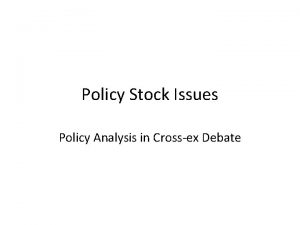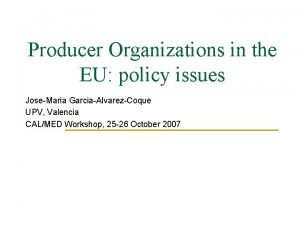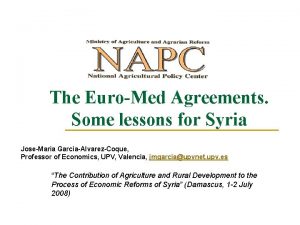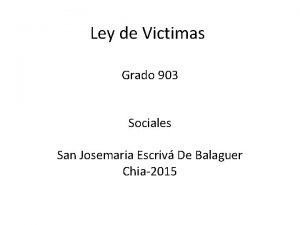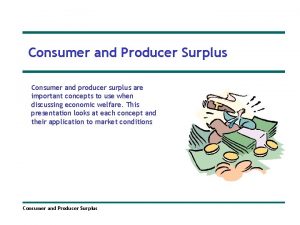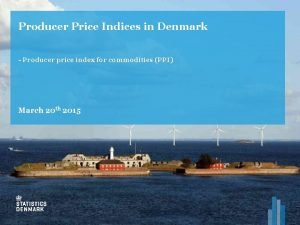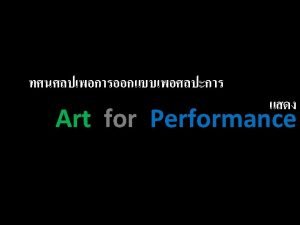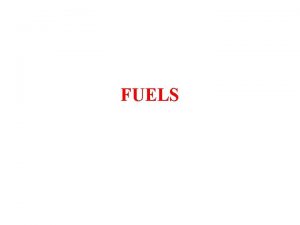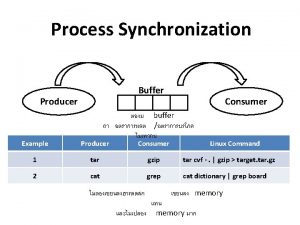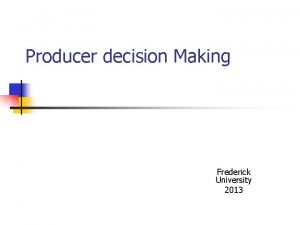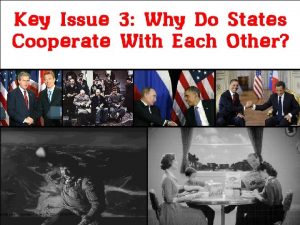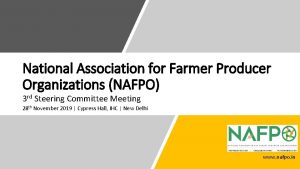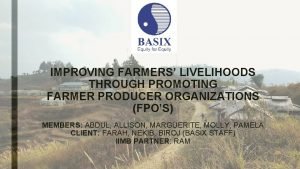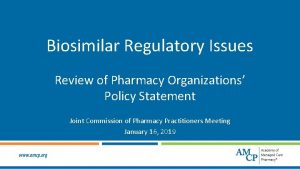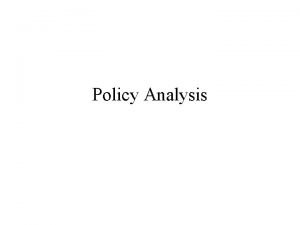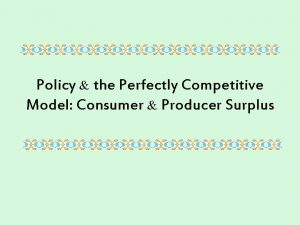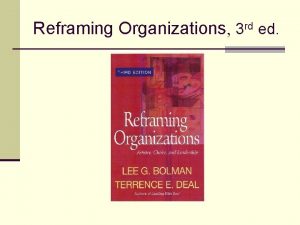Producer Organizations in the EU policy issues JoseMaria
























- Slides: 24

Producer Organizations in the EU: policy issues Jose-Maria Garcia-Alvarez-Coque UPV, Valencia CAL/MED Workshop, 25 -26 October 2007

Why collective action is relevant? n Supply chain challenges are a key factor for cooperation. n Stakeholders share interests in: q cost reduction q quality upgrading q risk management q relational rents n But cooperation is constrained by trade-offs in aspects of value distribution, transaction costs and trust.

Alternative pathways for cooperation 1. 2. 3. 4. 5. 6. n Self-investment and production for downstream. Joint asset management. Multimarket management to diversify risks. Marketing organizations with increased bargaining power. Contractual arrangements with stakeholders operating on behalf of retail firms. Co-ownership cooperatives to reduce information failures. Cooperation can be vertical or horizontal

The EU policy n 1. 4 million producers of F&V (EU 25) n The EU has promoted the horizontal type (classes 1 to 4). n Since 1996, POs are the pillar of support for F&V (1. 5 billion € in 2005). An ultimate goal: grouping of supply to balance retailers’ market power. Instruments are addressed to increase ATTRACTIVENESS. n n

Characteristics of POs n n 1 500 producer organisations in the EU 15 Minimum 5 members and € 100, 000 of VMP. Member States can have stricter criteria. Legal forms: cooperatives, groups of individuals or companies.

Number of POs in 2004

Average VMP per PO 2004 (Mio EUR)

Measures to support POs q q Support to establishment (preferential loans). Withdrawals Processing aids Operational Programs n n n Co-financed by farmers. Limited to 4. 1% of the VMP. Measures include quality improvement, marketing activities, promotion campaigns, development of organic or integrated and environmentally friendly production.

Support through POs (EU 15)

Assessment of EU policies (criteria) 1. 2. 3. 4. Compliance with WTO rules Effectiveness with EU objectives. Market asymmetries and efficiency Attractiveness

1. Compliance with WTO rules n n Withdrawals and processing aids are “amber box” policies. Operational programs are basically “green box” measures. Some measures included in the operational program addressed to crisis management. Are operational programs actionable? q They provide with incentives to increase competitiveness q They can be misused to reduce general production costs.

2. Effectiveness n n n In 2005, the Court of Auditors assessed effectiveness. The Commission introduces eligibility lists. The MS ensure that programs support objectives. But focus is on showing implementation rather than achievement of objectivea. Some POs use the subsidy to support the costs of existing activities. An evaluation study by the Commission is scheduled to start in 2008.

Impact on EU objectives Source: EUROPEAN COURT OF AUDITORS

3. Market asymmetries and efficiency n n n In some MS, POs are becoming “preferred suppliers”. In others, levels of organization remain weak. Part of the asymmetry of power cannot disappear. The behavior of many cooperatives does not help: q q q n n “supply oriented” strategies contribute to surpluses. contribute to the lack of market transparency. Producer grouping and farm incomes are favored with the same instruments. Some structures were formed to “crop the aids”. Many private stakeholders don’t receive support.

4. Attractiveness: share of POs in total VMP

Value of marketed production in 2004

POs' share of the total VMP by MS

Why are they not attractive enough? n n There should be potential for “Growing success. But POs are not attractive enough for farmers: q q q No history in cooperation. Many producers in Southern Europe work for local markets or deal directly with traders. Lack of flexibility of the framework. Strict requirements for extension of rules. Heavy bureaucracy for supporting schemes. Lack of professional management in some MS. Lack of trust related to their limited effectiveness.

Case study. Valencia region n n Strongly specialized in citrus. 60 thousand growers. 35 thousand growers in 115 POs in 2004. In 1994, POs marketed 1. 4 million T (30 % of total production). A decade later, figures were very similar. Reasons: q q q Lack of trust on cooperatives Perceived advantages are related to payment guarantee. But better prices are usually paid by private operators. Local authorities favor cooperatives. This puts outsourcing and some associations in disadvantage.

What is expected to change (I) n Regulation No 1182/2007 amends previous F&V rules. n More flexible legal framework: obligation to provide technical means only “if necessary”. Co-finance of Operational Programs increased to 60% for some cases (new PO Association, PO merger, promotional measures). National strategies in line with rural development. Compulsory inclusion of environmental actions. n n n

What is expected to change (II) n Prevention and crisis management by POs: support ceiling rises to 4. 6% of the VMP. q n n Green harvesting or no harvesting, withdrawal and free distribution, harvesting insurances, promotion and communication, training…). Decoupling of processing aids: transition period 5 years for perennials. MS may retain criteria for eligibility (e. g. PO membership).

Possible developments n n n New forms for POs will be created. Some existing POs will face problems. Money for Operational Programs will increase gradually (50 million € per year until 2013). Some POs will take over cultivation activities as members become aged. Decoupling will have limited impact on production. Operational programs vs. rural development.

Thanks for your attention

Typical contents of an operational programme n n n Purchase of sorting and packing machinery. Employment of quality control staff and marketing staff. Investments in irrigation facilities and greenhouses. Subsidies to growers for replanting fruit trees. Costs of natural pest and disease control approaches.
 Stock issues format
Stock issues format Thiếu nhi thế giới liên hoan
Thiếu nhi thế giới liên hoan Vẽ hình chiếu vuông góc của vật thể sau
Vẽ hình chiếu vuông góc của vật thể sau Một số thể thơ truyền thống
Một số thể thơ truyền thống Thế nào là hệ số cao nhất
Thế nào là hệ số cao nhất Hệ hô hấp
Hệ hô hấp Frameset trong html5
Frameset trong html5 Số.nguyên tố
Số.nguyên tố đặc điểm cơ thể của người tối cổ
đặc điểm cơ thể của người tối cổ Mật thư tọa độ 5x5
Mật thư tọa độ 5x5 Các châu lục và đại dương trên thế giới
Các châu lục và đại dương trên thế giới Glasgow thang điểm
Glasgow thang điểm ưu thế lai là gì
ưu thế lai là gì Thẻ vin
Thẻ vin Tư thế ngồi viết
Tư thế ngồi viết Cái miệng nó xinh thế chỉ nói điều hay thôi
Cái miệng nó xinh thế chỉ nói điều hay thôi Các châu lục và đại dương trên thế giới
Các châu lục và đại dương trên thế giới Bổ thể
Bổ thể Từ ngữ thể hiện lòng nhân hậu
Từ ngữ thể hiện lòng nhân hậu Tư thế ngồi viết
Tư thế ngồi viết Giọng cùng tên là
Giọng cùng tên là Thơ thất ngôn tứ tuyệt đường luật
Thơ thất ngôn tứ tuyệt đường luật Làm thế nào để 102-1=99
Làm thế nào để 102-1=99 Chúa yêu trần thế alleluia
Chúa yêu trần thế alleluia Khi nào hổ mẹ dạy hổ con săn mồi
Khi nào hổ mẹ dạy hổ con săn mồi
